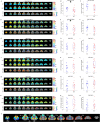Longitudinal investigation of changes in resting-state co-activation patterns and their predictive ability in the zQ175 DN mouse model of Huntington's disease
- PMID: 37353500
- PMCID: PMC10290061
- DOI: 10.1038/s41598-023-36812-y
Longitudinal investigation of changes in resting-state co-activation patterns and their predictive ability in the zQ175 DN mouse model of Huntington's disease
Abstract
Huntington's disease (HD) is a neurodegenerative disorder caused by expanded (≥ 40) glutamine-encoding CAG repeats in the huntingtin gene, which leads to dysfunction and death of predominantly striatal and cortical neurons. While the genetic profile and clinical signs and symptoms of the disease are better known, changes in the functional architecture of the brain, especially before the clinical expression becomes apparent, are not fully and consistently characterized. In this study, we sought to uncover functional changes in the brain in the heterozygous (HET) zQ175 delta-neo (DN) mouse model at 3, 6, and 10 months of age, using resting-state functional magnetic resonance imaging (RS-fMRI). This mouse model shows molecular, cellular and circuitry alterations that worsen through age. Motor function disturbances are manifested in this model at 6 and 10 months of age. Specifically, we investigated, longitudinally, changes in co-activation patterns (CAPs) that are the transient states of brain activity constituting the resting-state networks (RSNs). Most robust changes in the temporal properties of CAPs occurred at the 10-months time point; the durations of two anti-correlated CAPs, characterized by simultaneous co-activation of default-mode like network (DMLN) and co-deactivation of lateral-cortical network (LCN) and vice-versa, were reduced in the zQ175 DN HET animals compared to the wild-type mice. Changes in the spatial properties, measured in terms of activation levels of different brain regions, during CAPs were found at all three ages and became progressively more pronounced at 6-, and 10 months of age. We then assessed the cross-validated predictive power of CAP metrics to distinguish HET animals from controls. Spatial properties of CAPs performed significantly better than the chance level at all three ages with 80% classification accuracy at 6 and 10 months of age.
© 2023. The Author(s).
Conflict of interest statement
The authors declare no competing interests.
Figures






Similar articles
-
Evolution of aberrant brain-wide spatiotemporal dynamics of resting-state networks in a Huntington's disease mouse model.Clin Transl Med. 2024 Oct;14(10):e70055. doi: 10.1002/ctm2.70055. Clin Transl Med. 2024. PMID: 39422700 Free PMC article.
-
Resting-state fMRI reveals longitudinal alterations in brain network connectivity in the zQ175DN mouse model of Huntington's disease.Neurobiol Dis. 2023 Jun 1;181:106095. doi: 10.1016/j.nbd.2023.106095. Epub 2023 Mar 22. Neurobiol Dis. 2023. PMID: 36963694
-
Characterization of neurophysiological and behavioral changes, MRI brain volumetry and 1H MRS in zQ175 knock-in mouse model of Huntington's disease.PLoS One. 2012;7(12):e50717. doi: 10.1371/journal.pone.0050717. Epub 2012 Dec 20. PLoS One. 2012. PMID: 23284644 Free PMC article.
-
Characterization of Behavioral, Neuropathological, Brain Metabolic and Key Molecular Changes in zQ175 Knock-In Mouse Model of Huntington's Disease.PLoS One. 2016 Feb 9;11(2):e0148839. doi: 10.1371/journal.pone.0148839. eCollection 2016. PLoS One. 2016. PMID: 26859386 Free PMC article.
-
Characterization of HTT inclusion size, location, and timing in the zQ175 mouse model of Huntington's disease: an in vivo high-content imaging study.PLoS One. 2015 Apr 10;10(4):e0123527. doi: 10.1371/journal.pone.0123527. eCollection 2015. PLoS One. 2015. PMID: 25859666 Free PMC article.
Cited by
-
Evolution of aberrant brain-wide spatiotemporal dynamics of resting-state networks in a Huntington's disease mouse model.Clin Transl Med. 2024 Oct;14(10):e70055. doi: 10.1002/ctm2.70055. Clin Transl Med. 2024. PMID: 39422700 Free PMC article.
-
Longitudinal alterations in brain perfusion and vascular reactivity in the zQ175DN mouse model of Huntington's disease.J Biomed Sci. 2024 Apr 16;31(1):37. doi: 10.1186/s12929-024-01028-3. J Biomed Sci. 2024. PMID: 38627751 Free PMC article.
-
Longitudinal Investigation of Structural and Resting-State Effective Connectivity Alterations in a Non-Human Primate Model of Huntington's Disease.bioRxiv [Preprint]. 2025 Jul 23:2025.07.18.665554. doi: 10.1101/2025.07.18.665554. bioRxiv. 2025. PMID: 40777463 Free PMC article. Preprint.
-
Early altered directionality of resting brain network state transitions in the TgF344-AD rat model of Alzheimer's disease.Front Hum Neurosci. 2024 Apr 5;18:1379923. doi: 10.3389/fnhum.2024.1379923. eCollection 2024. Front Hum Neurosci. 2024. PMID: 38646161 Free PMC article.
-
Modular subgraphs in large-scale connectomes underpin spontaneous co-fluctuation events in mouse and human brains.Commun Biol. 2024 Jan 24;7(1):126. doi: 10.1038/s42003-024-05766-w. Commun Biol. 2024. PMID: 38267534 Free PMC article.
References
-
- Nanetti L, Contarino VE, Castaldo A, Sarro L, Bachoud-Levi A-C, Giavazzi M, Frittoli S, Ciammola A, Rizzo E, Gellera C, et al. Cortical thickness, stance control, and arithmetic skill: An exploratory study in premanifest Huntington disease. Parkinsonism Relat. Disord. 2018;51:17–23. doi: 10.1016/j.parkreldis.2018.02.033. - DOI - PubMed
Publication types
MeSH terms
LinkOut - more resources
Full Text Sources
Medical
Miscellaneous

